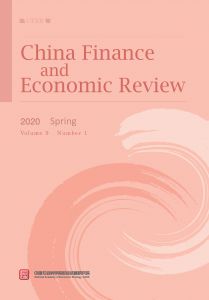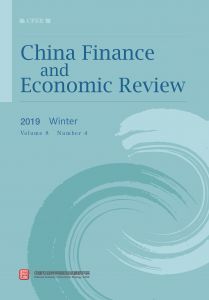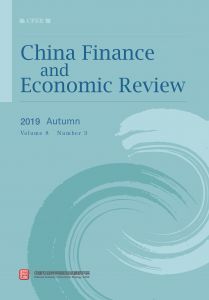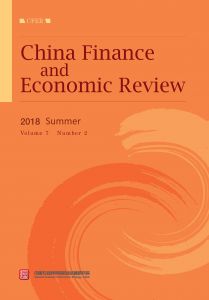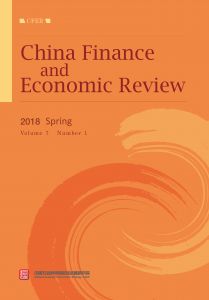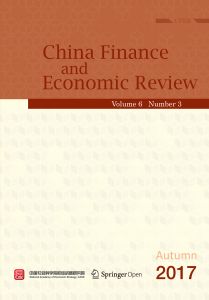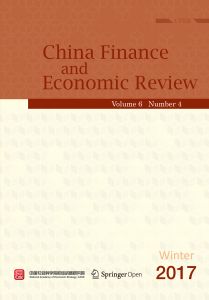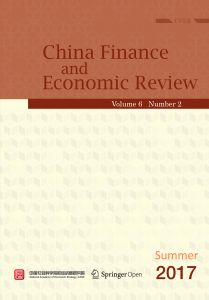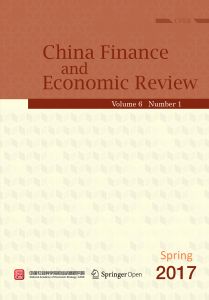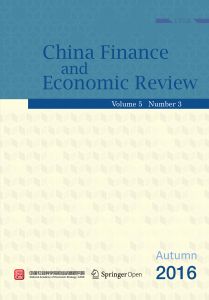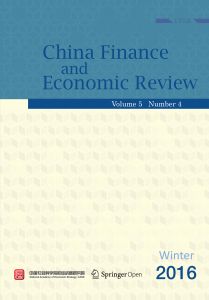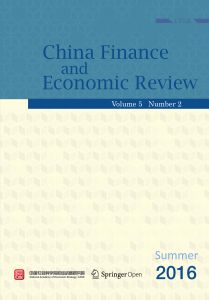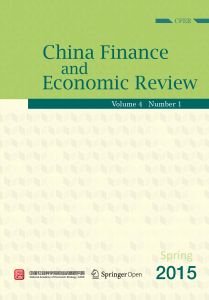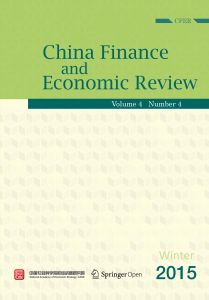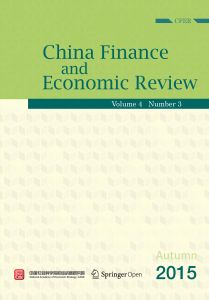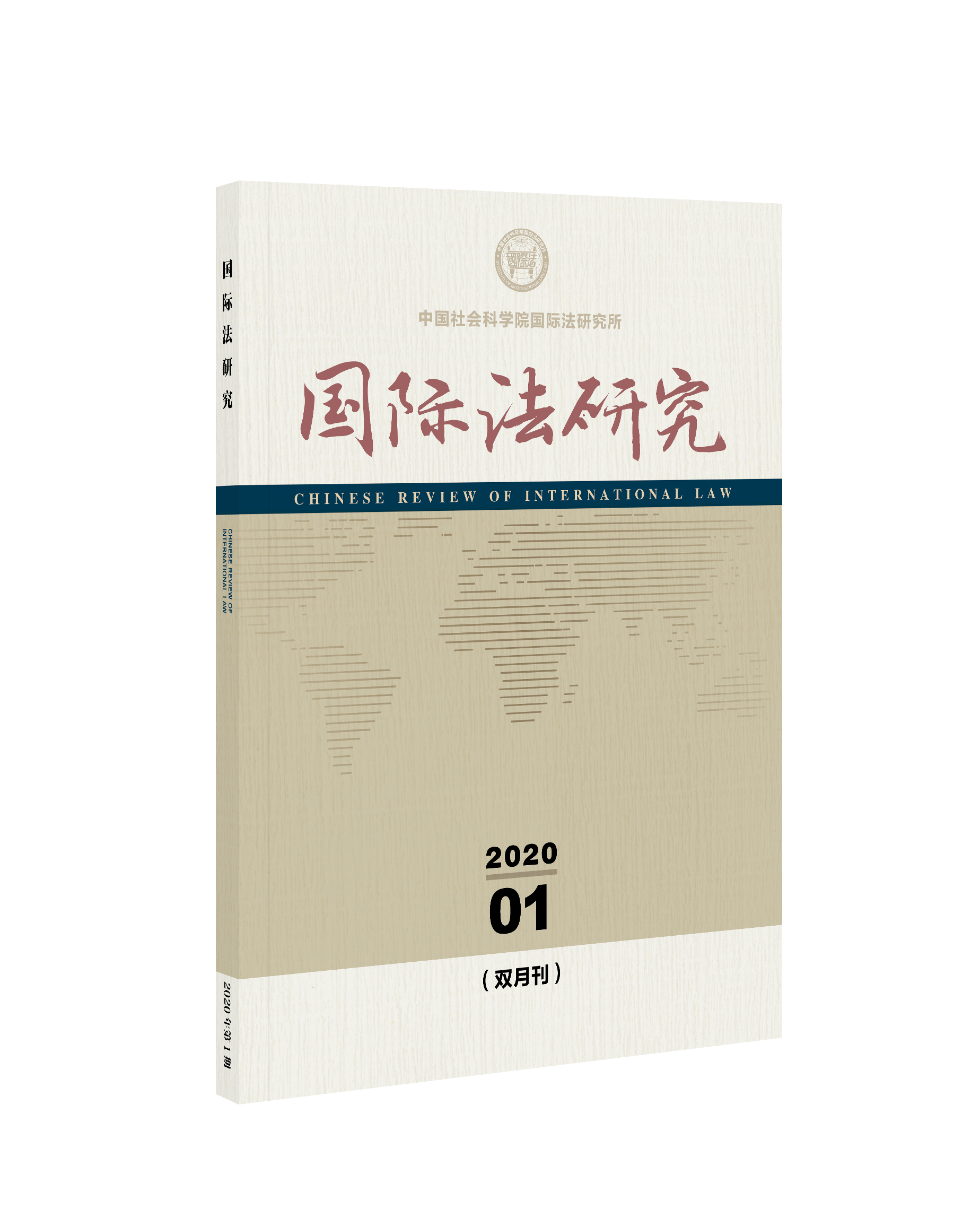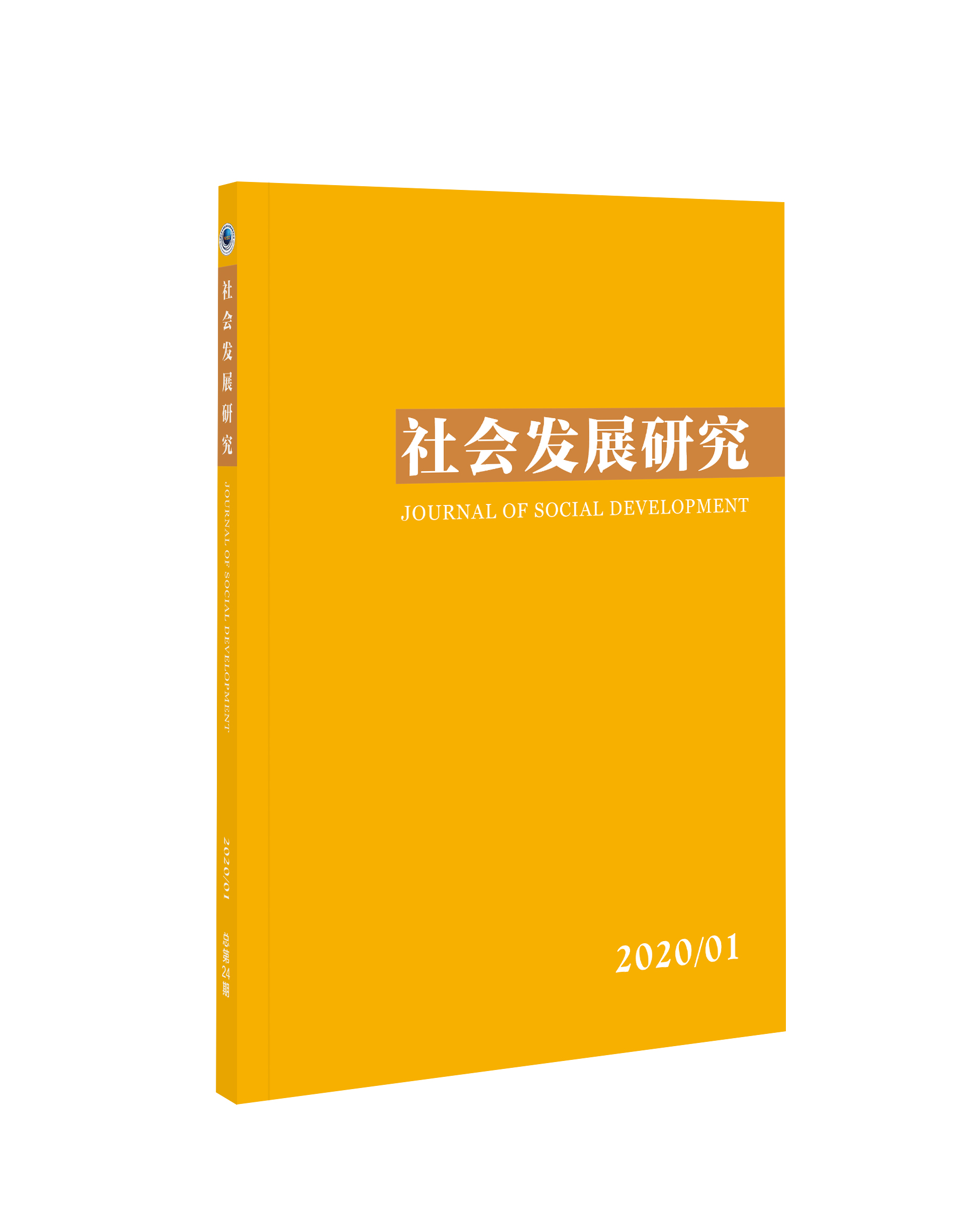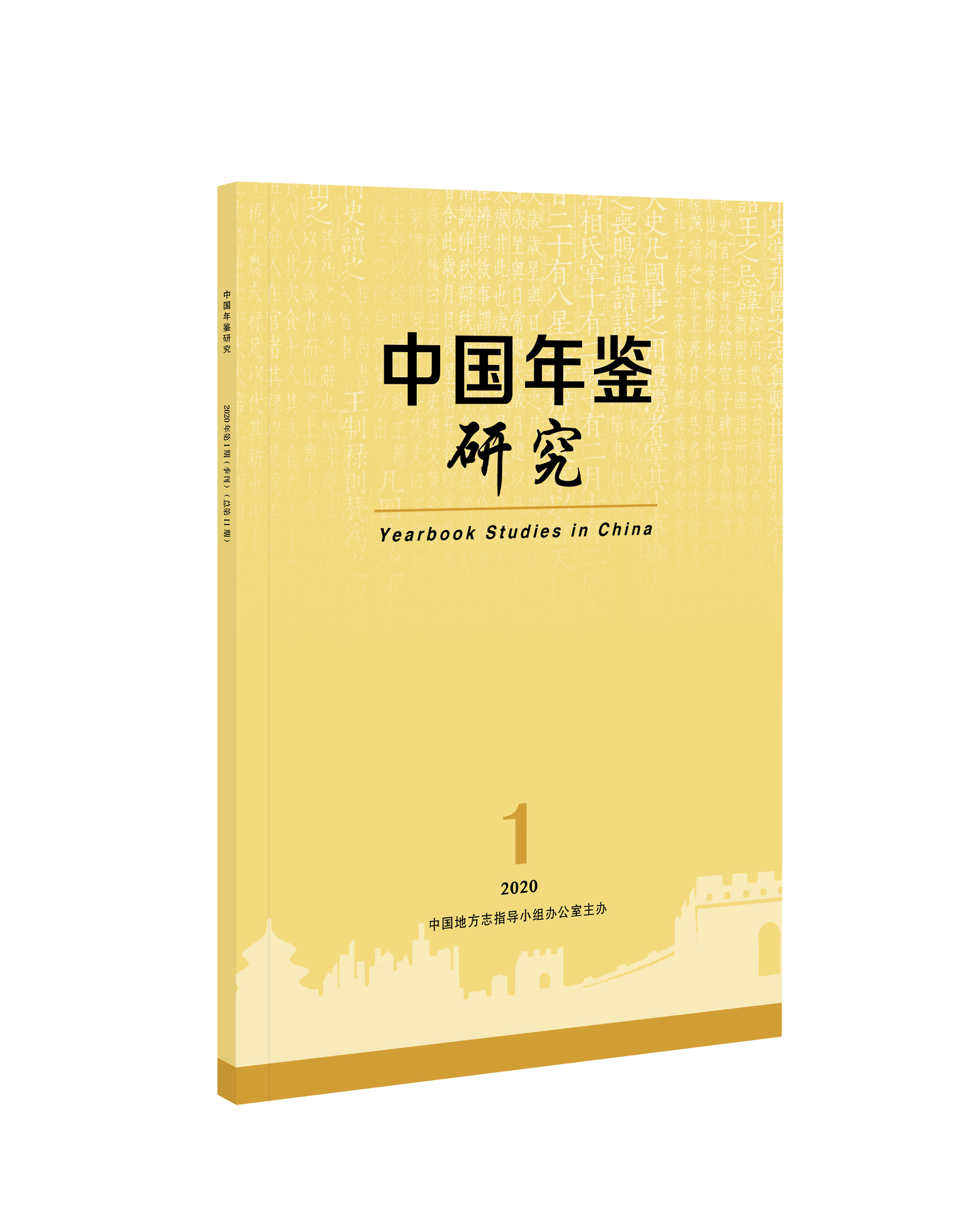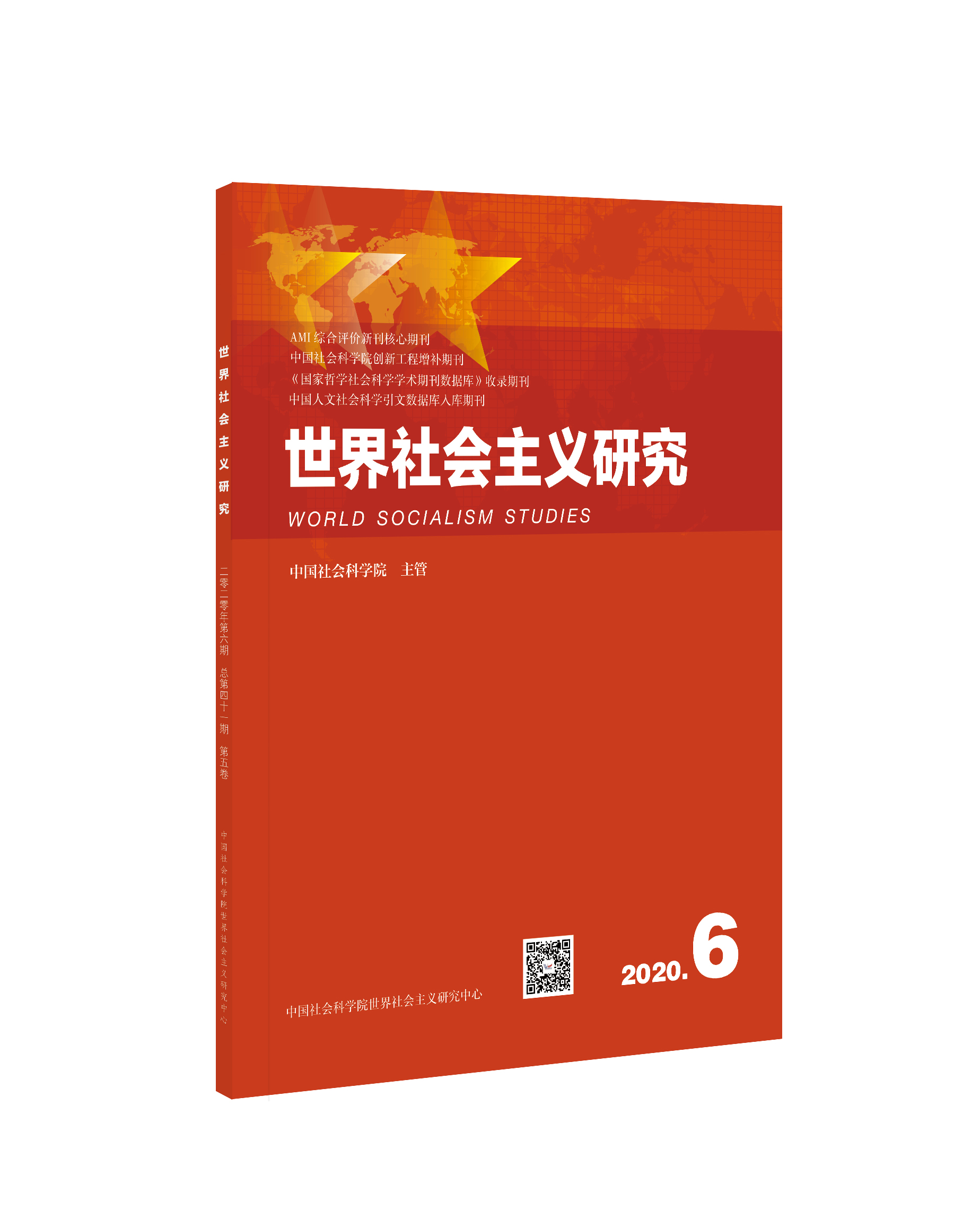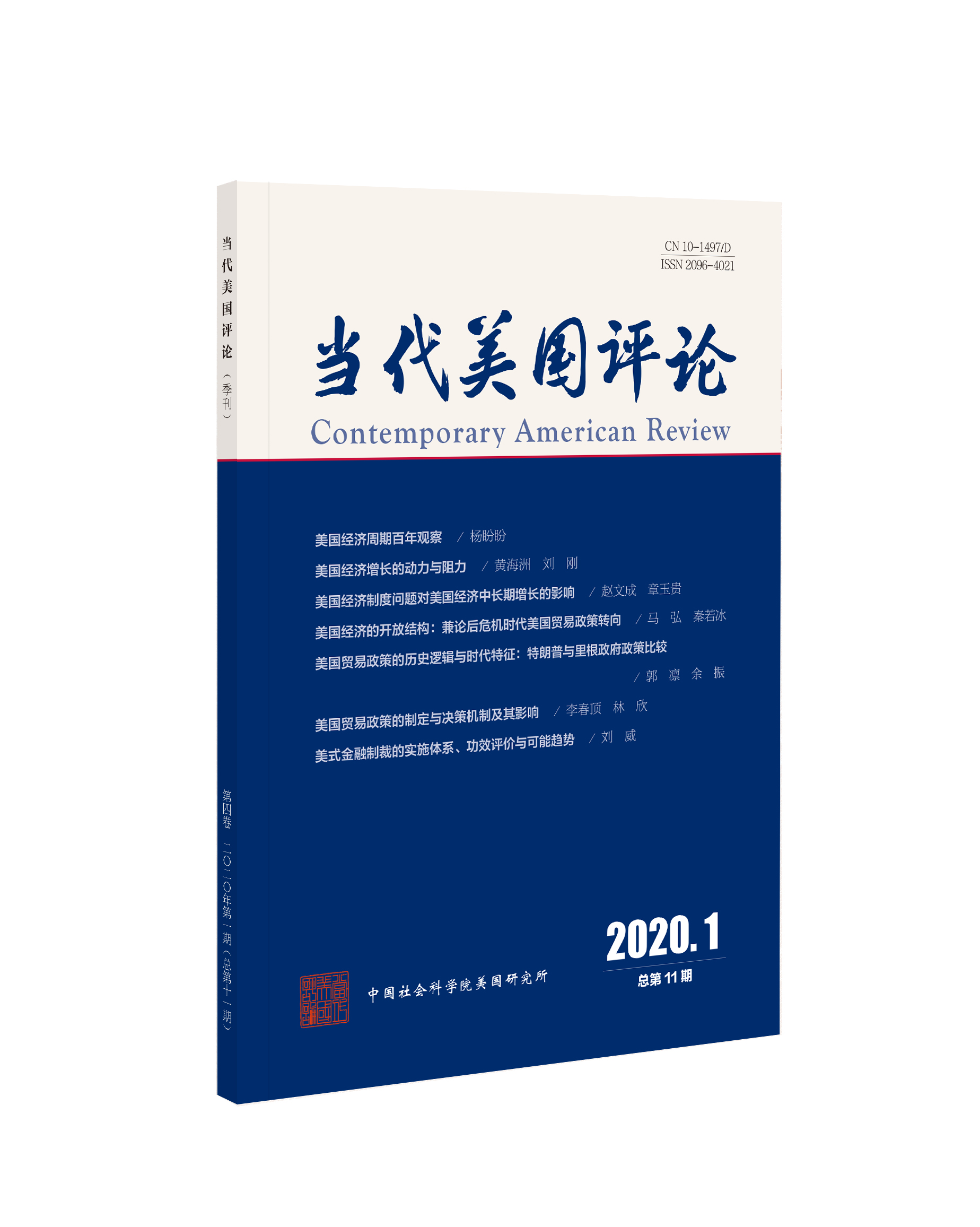最新期刊
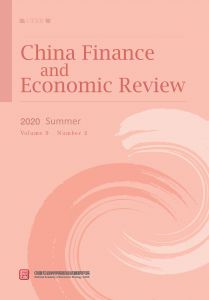
目录
过往期刊
参考文献
-
Instructions for Authors
-
编委会
-
Estimation of China’s Industry-Level TFP and Analysis of Growth Drivers
-
1. Introduction
-
2. Accounting Framework
-
3. Data
-
4. Industrial TFP of China
-
5. China’s Growth Drivers
-
6. Conclusions
-
-
Promoting China’s Industrial Upgrading by Expanding the Opening-Up of Service Industry: Intrinsic Logic and Realization Approach
-
1. Tertiarization: The General Trend of World Economic Development
-
2. Intrinsic Logic of Promoting Transformation and Upgrading through Opening-Up of Service Industry
-
3. Realization Approach of Promoting China’s Industrial Upgrading by Expanding the Opening-Up of Service Industry
-
-
Opportunity Inequality in Income Gap of China—A Decomposition Based on Regression Equation
-
1. Introduction
-
2. Literature Overview
-
3. Measuring Methods and Data of Opportunity Inequality
-
4. Empirical Result and Analysis
-
5. Conclusion and Policy Suggestions
-
-
The Mechanism of Internet Promoting Balanced Urban-Rural Development and China’s Practice
-
1. Introduction
-
2. An analysis of the Mechanism of the Internet Narrowing the Urban-Rural Gap
-
3. Internet Plays a Positive Role in Narrowing the Urban-Rural Gap: Based on China’s Practice
-
4. Conclusions and Policy Recommendations
-
-
Urban Inclusiveness and Entrepreneurship: Evidence from Microdata on Migrants
-
1. Introduction
-
2. Literature Review and Research Hypotheses
-
3. Data, Variables and Empirical Method
-
4. Analysis on Regression Result
-
5. Further Analysis in Expansion
-
6. Conclusions
-
-
Potential Impact for Issuing Libra in Financial Systems and Policy Implications
-
1. Characteristics of Libra
-
2. Potential Impact of Libra
-
3. More Issues to Be Considered
-
4. Libra’s Impact on Sovereign Currency, Financial Regulation and Commercial Banks
-
5. Libra’s Impact on China
-
6. Libra Still Has a Long Way to Go from Planning to Implementation
-
7. Policy Implications
-
8. Conclusion
-
按年份浏览:
- 全部
- 2020
- 2019
- 2018
- 2017
- 2016
- 2015
- 2014
- 2013
[1][1]Bai, C., & Zhang, Q. (2014). Productivity Explanation of China’s Economic Slowdown. Comparative Studies (Bijiao) , 73(4), 1-19.
[2][2]Bai, C., & Zhang, Q. (2015). Estimation of China’s Productivity and Analysis of its Fluctuations. The Journal of World Economy (Shijie Jingji) , 38(12), 3-28.
[3][3]Brandt, L., & Zhu, X. (2010). Accounting for China’s Growth. IZA Discussion Paper.
[4][4]Brandt, L., Tombe, T., & Zhu, X. (2013). Factor Market Distortions Across Time, Space and Sectors in China. Review of Economic Dynamics , 16, 39-58.
[5][5]Brandt, L., Van Biesebroeck, J., & Zhang, Y. (2012). Creative Accounting or Creative Destruction? Firm-Level Productivity Growth in Chinese Manufacturing. Journal of Development Economic , 97(2), 339-351.
[6][6]Cai, F., Lin, Y., Zhang, X., Zhu, L., & Lv, Z. (2018). Forty Years of Reform and Openging Up and China’s Economic Development. Economic Pespectives (Jingjixue Dongtai) , 8, 4-17.
[7][7]Cai, Y., & Fu, Y. (2017). The Technical and Structural Effects of TFP Growth: Measurement and Decomposition Based on China’s Macro and Sector Data. Economic Research Journal (Jingji Yanjiu) , 1, 72-88.
[8][8]Cao, J., Ho, M., Jorgenson, D., Ren, R., Sun, L., & Yue, X. (2009). Industrial and Aggregate Measures of Productivity Growth in China, 1982-2000. Review of Income and Wealth , 55(1), 485-513.
[9][9]Chen, B., Jin, Y., & Ouyang, D. (2015). Housing Price, Resource Mismatch and the Productivity of China’s Industrial Enterprises. The Journal of World Economy (Shijie Jingji) , 38(4), 77-98.
[10][10]Chenery, H. B., Robinson, S., & Syrquin, M. (1986). Industrialization and Growth: A Comparative Study . New York: Oxford University Press. Chow, G. C. (1993). Capital Formation and Economic Growth in China. The Quarterly Journal of Economics , 108(3), 809-842.
[11][11]Chow, G., & Lin, A. (2002). Accounting for Economic Growth in Taiwan and Mainland China: A Comparative Analysis. Journal of Comparative Economics , 30(3), 507-530.
[12][12]Christensen, L. R., & Jorgenson, D. W. (1969). The Measurement of U. S. Real Capital Input, 1929-67. Review of Income and Wealth , 4, 293-320.
[13][13]Dollar, D., & Wei, S. (2007). Das (Wasted) Kapital: Firm Ownership and Investment Efficiency in China. IMF Working Paper.
[14][14]Gai, Q., Zhu, X., Cheng, M., & Shi, Q. (2017). Inappropriate Allocation of Land Resources and Labor Productivity. Economic Research Journal (Jingji Yanjiu) , 5, 117-130.
[15][15]Guo, Q., & Jia, J. (2005). Estimating Total Factor Productivity in China. Economic Research Journal (Jingji Yanjiu) , 6, 51-60.
[16][16]Hsieh, C., & Klenow, P. (2009). Misallocation and Manufacturing TFP in China and India. Quarterly Journal of Economics , 4, 1043-1448.
[17][17]Hu, Y., & Chen, D. (2019). Decomposition of Total Factor Productivity Growth Rate in China’s High-tech Industries—A Test for The Structural Bonus Hypothesis. China Industrial Economics (Zhongguo Gongye Jingji) , 2, 136-154.
[18][18]Jiang, F., Wu, P., & Li, X. (2014). The Dynamic Mechanism Transform of China’s Industrial Economic Growth. China Industrial Economics (Zhongguo Gongye Jingji) , 5, 5-17.
[19][19]Jorgenson, D. W. (1963). Capital Theory and Investment Behavior. American Economic Review , 53(2), 247-259.
[20][20]Jorgenson, D. W., & Griliches, Z. (1967). The Explanation of Productivity Change. Review of Economic Studies , 34 (3), 249-83.
[21][21]Jorgenson, D. W., Berndt, R. E., & Triplett, E. J. (1990). Productivity and Economic Growth In Fifty Years of Economic Measurement , 19-118.
[22][22]Jorgenson, D. W., Gollop, M. F., & Fraumeni, M. B. (1987). Productivity and U.S. Economic Growth . Cambridge: Harvard University Press.
[23][23]Jorgenson, D. W., Ho, M. S., & Stiroh, K. J. (2005). Information Technology and the American Growth Resurgence, Productivity . Cambridge: MIT Press.
[24][24]Lin, J. Y. (1992). Rural Reforms and Agriculture Growth in China. American Economic Review , 82, 34-51.
[25][25]Massell, B. F. (1961). A Disaggregated View of Technical Change. Journal of Political Economy , 69 (6), 547-557.
[26][26]OECD. (2001). Measuring Productivity OECD Manual . OECD Publications.
[27][27]Ren, R., & Sun, L. (2009). Estimation of China’s TFP on the Sector Level. China Economic Quarterly (Jingjixue Jikan) , 3, 925-950.
[28][28]Solow, R. M. (1957). Technical Change and the Aggregate Production Function. Review of Economics and Statistics , 39(3), 312-20.
[29][29]Song, M., Storesletten, K., & Zilibotti, F. (2011). Growing Like China. American Economic Review , 101, 202-241.
[30][30]Sun, L., Zheng, H., & Ren, R. (2012). Contribution of Informatization to China’s Economic Growth: Empirical Evidence of Industrial Panel Data. The Journal of World Economy (Shijie Jingji) , 2, 3-25.
[31][31]Tombe, T., & Zhu, X. (2019). Trade, Migration and Aggregate Productivity: A Quantitative Analysis of China. American Economic Review , 109(5), 1843-1872.
[32][32]Wu, H. (2015). Constructing China’s Net Capital and Measuring Capital Services in China,1980-2010. RIETI Discussion Paper, 2015b, E-006.
[33][33]Wu, H. (2015). On China’s Strategic Move For A New Stage of Development—A Productivity Perspective. The Third World KLEMS Conference Working Paper.
[34][34]Wu, H. (2019). China’s Forty Years of Productivity Growth—Towards a Theory-Methodology-Measurement Coherent Analysis. The Fifth Asian KLEMS Conference Working Paper.
[35][35]Wu, H., & Ito, K. (2015). Reconstructing China’s Supply-Use and Input-Output Tables in Time Series. RIETI Discussion Paper, 2015, E-004.
[36][36]Wu, H., Yue, X., & Zhang, G. (2015). Constructing Annual Employment and Compensation Matrices and Measuring Labor Input in China. RIETI Discussion Paper, 2015, E-005.
[37][37]Xu, X. (2013). An Accurate Understanding of Income, Consumption, and Investment in China. Social Sciences in China (Zhongguo Shehui Kexue) , 2, 4-24.
[38][38]Xu, X., Zhang, Z., Chang, Z., & Lei, Z. (2020). Industrial Productivity and Economic Growth Drivers in China. The Journal of World Economy (Shijie Jingji) , 2, 25-48.
[39][39]Yang, R. (2015). Study on the Total Factor Productivity of Chinese Manufacturing Enterprises. Economic Research Journal (Jingji Yanjiu) , 2, 61-76.
[40][40]Yuan, Z., & Xie, D. (2011). Analysis on the Impact of Labor Mismatch on TFP in China. Economic Research Journal (Jingji Yanjiu) , 7, 4-17.
[41][41]Zhang, J. (2002). Capital Formation, Industrialization and Economic Growth: Understanding China’s Economic Reform. Economic Research Journal (Jingji Yanjiu) , 6, 3-13.
[42][42]Zhang, Z. (2015). A Gross Output Accounting Framework for the Effect of Resource Misallocation on TFP. Statistical Research (Tongji Yanjiu) , 32(12), 22-29.
[43][43]Zhu, T., Zhu, T., Zhang, J. & Liu, F. (2017). How Accurate Is China’s Investment Data, China Economic Quarterly (Jingjixue Jikan) , 3, 1199-1218.
[44][44]Jiang, X. J., & Luo, L. B. (2019). Service Globalization in the Internet Age: New Engine, Acceleration and Competitiveness of Major Countries. Social Sciences in China (Zhongguo Shehui Kexue) , 2, 68-91 + 205-206.
[45][45]Li, X. Q. (2018). Integration and Effect of Productive Services and Manufacturing in the United States . Doctoral Dissertation, Hebei University.
[46][46]Li, Y. J. (2020). Internet Platforms Accelerate China’s Digitalization Process in Anti-Epidemic. China Newspaper Industry (Zhongguo Baoye) , 5, 48-49.
[47][47]Liu, Y., & Xia, J. C. (2016). Research Trends of Sharing Economy Theory and Policy. Economic Perspectives (Jingjiexue Dongtai) , 4,116-125.
[48][48]Tang, R., & Gu, N. H. (2018). Value Chain Embedding and Manufacturing Resource Mismatch Improvement in Upstream Productive Services. Industrial Economics Research (Chanye Jingji Yanjiu) , 3, 13-26.
[49][49]Wang, X. H. (2019). International and Domestic Environment Analysis of China’s High-Quality Economic Development. Globalization (Quanqiuhua) , 10, 45-59 + 134.
[50][50]Xia, J. C. (2019). 70 Years of Service Economy Research in PRC: Evolution, Reference and Innovation. Finance & Trade Economics (Caimao Jingji) , 40 (10), 17-33.
[51][51]Xia, J. C., & Yao, Z. Q. (2018). 40 Years of Opening-Up of China’s Service Industry: Evolution, Openness Assessment and Experience Summary. Research on Financial and Economic Issues (Caijing Wenti Yanjiu) , 4, 3-14.
[52][52]Xia, J. C., & Ni, H. F. (2017). Reassessment of the Role of Service Trade: A Global Value Chain Perspective. Finance & Trade Economics (Caimao Jingji) , 38 (11), 115-130.
[53][53]Xia, J. C., & Xiao, Y. (2019). Promoting the Transformation and Upgrading of Service Industry with Service Innovation. Journal of Beijing University of Technology (Social Sciences Edition) (Beijing Gongye Daxue Xuebao, Shehui Kexueban) , 19 (5), 61-71.
[54][54]Xia, J. C. (2018). The Origin, International Experience and Development Strategy of Digital Trade. Journal of Beijing University of Technology (Social Sciences Edition) (Beijing Gongye Daxue Xuebao, Shehui Kexueban) , 33 (5), 1-10.
[55][55]Xiao, Y., Xia, J. C., & Ni, H. F. (2019). Spiral of China’s Manufacturing on Global Value Chain. The Journal of Quantitative & Technical Economics (Shuliang Jingji Jishu Jingji Yanjiu) , 36 (11), 40-59.
[56][56]Xu, J. H., & Zhou, R. R. (2019). Digital Trade Rule-Making: Development Trend, International Experience and Policy Recommendations. Intertrade (Guoji Maoyi) , 6, 61-68.
[57][57]Yao, Z. Q. (2018). Measurement of the Openness of China’s Service Industry and Analysis of Its International Competitiveness. Intertrade (Guoji Maoyi) , 9,48-54.
[58][58]Arneson, R. (1989). Equality and Equal Opportunity for Welfare. Philosophical Studies , 56(1), 77-93.
[59][59]Banerjee, A., & Newman, A. (1993). Occupational Choice and the Process of Development. Journal of Political Economy , 101(2), 274-298.
[60][60]Barry, B. X. (2005). Why Social Justice Matters . Cambridge: Polity Press.
[61][61]Björklund, A., Jäntti, M., & Roemer, J. (2011). Equality of Opportunity and the Distribution of Long-run Income in Sweden. Social Choice and Welfare , 39(2), 675-696.
[62][62]Björklund, A., & Salvanes, K. (2011). Education and Family Background: Mechanisms and Policies. In Hanushek, E., Machin, S., & Woessmann, L. (eds.), Handbook of the Economics of Education (Volume 3) (pp. 201-247). Amsterdam: North Holland.
[63][63]Bourguignon, F., Ferreira, F., & Menendez, M. (2007). Inequality of Opportunity in Brazil. Review of Income and Wealth , 53(4), 585-618.
[64][64]Checchi, D., & Peragine, V. (2010). Inequality of Opportunity in Italy. The Journal of Economic Inequality , 8(4), 429-450.
[65][65]Chen, D., & Huang, X. (2015). To What Extent Does Opportunity Inequality Affect Income Inequality?-From the Perspective of Inter-Generational Transmission. Economic Review (Jingji Pinglun) , 1, 3-16.
[66][66]Cohen, G. A. (1989). On the Currency of Egalitarian Justice. Ethics , 99(4), 906-944.
[67][67]Dong, L. (2018). Income & Opportunity Inequality in China-A Study Based on China Household Income Projects 2013. Studies in Labor Economics (Laodong Jingji Yanjiu) , 6(1), 44-62.
[68][68]Dworkin, R. (1981a). What Is Equality? Part 1: Equality of Welfare. Philosophy and Public Affairs , 10(3), 185-246.
[69][69]Dworkin, R. (1981b). What Is Equality? Part 2: Equality of Resources. Philosophy and Public Affairs , 10(4), 283-345.
[70][70]Ferreira, F., & Gignoux, J. (2011). The Measurement of Inequality of Opportunity: Theory and an Application to Latin America. Review of Income and Wealth , 57(4), 1475-4991.
[71][71]Gong, F., Li, Z., & Lei, X. (2017). Effects of Efforts on Opportunity Inequality: Measurement & Comparison. Economic Research Journal (Jingji Yanjiu) , 3, 78-92.
[72][72]Jiang, Q., Ren, J., & Zhang, K. (2014). Study of Opportunity Inequality for Urban Residents in China. The Journal of World Economy (Shijie Jingji) , 37(4), 111-138.
[73][73]Lefranc, A., Pistolesi, N., & Trannoy, A. (2008). Inequality of Opportunities vs. Inequality of Outcomes: Are Western Societies All Alike? Review of Income and Wealth , 54(4), 513-546.
[74][74]Lefranc, A., Pistolesi, N., & Trannoy, A. (2009). Equality of Opportunity and Luck: Definitions and Testable Conditions, with an Application to Income in France. Journal of Public Economics , 93(11-12), 1189-1207.
[75][75]Lei, X., Jia, Y., & Gong, F. (2018). Measurement of Opportunity Inequality: Application and Improvement of Parametric Method. Statistical Research (Tongji Yanjiu) , 35(4), 73-85.
[76][76]Li, J., Wan, G., Wang, C., & Zhang, X. (2019). Which Indicator of Income Distribution Explains Crime Better? Evidence from China. China Economic Review , 54(4), 51-72.
[77][77]Li, L., & Zhou, G. (2014). Family Loan, Public Education Expenditure & Social Mobility. China Economic Quarterly (Jingjixue Jikan) , 1, 65-82. Li, Y., & Lv, G. (2016). To What Extent Does Opportunity Inequality Lead to Urban Income Inequality in China? Statistical Research (Tongji Yanjiu) , 33(8), 63-72.
[78][78]Li, Y., & Lv, G. (2018). Reasons for Opportunity Inequality in Income Distribution for Urban Residents in China. Statistical Research (Tongji Yanjiu) , 35(9), 69-80.
[79][79]Liu, B., Wang, X., & Peng, J. (2015). Opportunity Inequality in Income Gap of Chinese Residents—An Empirical Study Based on CGSS Data. Shanghai Journal of Economics (Shanghai Jingji Yanjiu) , 8, 79-90.
[80][80]Luo, C., & Liu, X. (2018). Educational Expansion & Inter-Generational Mobility of Education. Social Sciences in China (Zhongguo Shehui Kexue) , 2, 121-140.
[81][81]Luo, L., & Ru, X. (2019). Study of Opportunity Inequality in Income Distribution of China-Empirical Evidence Based on CGSS 2008-2015. China Soft Science (Zhongguo Ruankexue) , 340(4), 62-74.
[82][82]Marrero, G., & Rodriguez, J. (2012). Inequality of Opportunity in Europe. Review of Income and Wealth , 58(4), 597-621.
[83][83]Rawls, J. (1971). A Theory of Justice . Cambridge, MA and London: Harvard University Press.
[84][84]Roemer, J. E. (1993). A Pragmatic Theory of Responsibility for the Egalitarian Planner. Philosophy and Public Affairs , 22(2), 146-166.
[85][85]Roemer, J. E. (1998). Equality of Opportunity . Cambridge, MA and London: Harvard University Press.
[86][86]Roemer, J. E., & Trannoy, I. (2016). Equality of Opportunity: Theory and Measurement. Journal of Economic Literature , 54(4), 1288-1332.
[87][87]Sen, A. (1980). Equality of What. In McMurrin, S. M. (eds.), The Tanner Lectures on Human Values (Volume 1) (pp. 197-220). Salt Lake City: University of Utah Press.
[88][88]Shi, X., Wei, L., Fang, S., & Gao, X. (2018). Opportunity Inequality in Income Distribution of China. Management World (Guanli Shijie) , 34(3), 27-37.
[89][89]Singh, A. (2012). Inequality of Opportunity in Earnings and Consumption Expenditure: The Case of Indian Men. Review of Income and Wealth , 58(1), 79-106.
[90][90]Song, Y. (2017). Degree of Opportunity Inequality in China & Its Working Mechanism—An Empirical Analysis Based on CGSS Data. Finance & Trade Economics (Cai Mao Jingji) , 38(1), 34-50.
[91][91]Wan, G. (2004). Accounting for Income Inequality in Rural China. Journal of Comparative Economics , 32(2), 348-363.
[92][92]Wan, G. (2013). Urbanization and Inequality: Analytical Methods and China Cases. Economic Research Journal (Jingji Yanjiu) , 5, 74-87.
[93][93]Wan, G., & Zhou, Z. (2005). Income Inequality in Rural China: Regression-Based Decomposition Using Household Data. Review of Development Economics , 9(1), 107-120.
[94][94]Wan, G., Wu, T., & Zhang, Y. (2018). Decrease of Income Inequality in China and Analysis of Reasons. Studies in Labor Economics (Laodong Jingji Yanjiu) , 28(3), 23-54.
[95][95]Wang, C., Wan, G., & Zhang, X. (2019). Regional Difference and Structural Changes: China 1978- 2016. Management World (Guanli Shijie) , 6, 11-26.
[96][96]Yao, Y., Wan, G., & Meng, D. (2019). Income Distribution and Health: Can Polarization Explain Health Outcomes Better Than Inequality? The European Journal of Health Economics , 20(4), 543-557.
[97][97]Zhang, Y., & Eriksson, T. (2010). Inequality of Opportunity and Income Inequality in Nine Chinese Provinces, 1989-2006. China Economic Review , 21(4), 607-616.
[98][98]AliResearch. (2019). Research Report on Taobao Villages in China (2009-2019) , http://www.aliresearch.com/cn/presentation.
[99][99]Barkley, D. L., Lamie, R. D., & Markley, D. M. (2007). Case Studies of E-Commerce in Small and Medium-Sized Enterprises: A Review of the Literature. UCED Working Paper.
[100][100]Cairncross. (2001). The Death of Distance: How the Communications Revolution Is Changing Our Lives . Boston: Harvard Business School Press.
[101][101]CIECC. (2017). Report on China’s Rural E-commerce Development (2016-2017) .
[102][102]CIECC. (2018). Report on China’s Rural E-commerce Development (2017-2018) , http://www.199it.com/archives/805043.html.
[103][103]CNNIC. (2019). The 44th Statistical Report on Internet Development , http://www.cac. gov.cn/2019-08/30/c_.htm.
[104][104]Couture, V., Faber, B., Gu, Y. Z., & Liu, L. Z. (2018). E-Commerce Integration and Economic Development: Evidence from China , http://www.nber.org/papers/w24384. Goldfarb, A., & Tucker, C. (2018). Digital Economics. Working Paper 23684, http://www.nber.org/papers/w23684, National Bureau of Economic Research.
[105][105]Li, Y. J., & Wang, C. Q. (2016). Risk Identification, Future Value and Credit Capitalization: Research on the Theory and Policy of Poverty Alleviation by Internet Finance. China Finance and Economy Review , 5(3), 38-50.
[106][106]Li, Y. J., & Wang, T. (2016). Blue Book of Internet Finance of “Agriculture, Rural Areas, and Farmers” in China (ed) . Beijing: Social Sciences Academic Press. (in Chinese)
[107][107]Liu, H., & Zhang, J. P. (2016). Impact of Internet on Consumption Structure of Rural Residents and Regional Differences. Finance & Economics (Caijing Kexue) , 4, 80-88.
[108][108]Mao, Y. F., & Li, Y. (2016). Internet and Human Capital: A New Engine of Modern Agricultural Economic Growth—An Empirical Study Based on China’s Provincial Panel Data. Rural Economy (Nongcun Jingji) , 6,113-118.
[109][109]McKinsey. (2013). China’s E-Tail Revolution , https://www.mckinsey.com/featured-insights/asia-pacific/china-e-tailing.
[110][110]Nath, P. (2015). E-Commerce: Socio-Economy Impact. The Echo (an online journal of humanities and social sciences) , 1, 223.
[111][111]Rosston, G., Savage, S., & Waldman, D. (2010). Household Demand for Broadband Internet Service. Discussion Papers 09-008, Stanford Institute for Economic Policy Research.
[112][112]Sinai, T., & Waldfogel, J. (2004). Geography and the Internet: Is the Internet a Substitute or a Complement for Cities? Journal of Urban Economics , 56(1), 1-24.
[113][113]Sunstein, C. R. (2003). Republic.com . Shanghai: Shanghai People’s Publishing House.
[114][114]World Bank.(2016). World Development Report 2016: Digital Dividends , http://www. worldbank.org/wdr2016.
[115][115]Cai, F. (2017). Reform Effects in China: A Perspective of Labor Reallocation. Economic Research Journal (Jingji Yanjiu) , 7, 4-17.
[116][116]Chen, G. (2015). Control and Entrepreneurship: Evidence from Microdata in China. Management World (Guanli Shijie) , 5, 89-99.
[117][117]Chen, Y. (2012). Village-Based Networks and Wages of Rural-to-Urban Migrants: Estimating the Causal Effects of Networks Using Combined Identification Strategies. Society (Shehui) , 4, 68-92.
[118][118]Diamond, R. (2016). The Determinants and Welfare Implications of US Workers’ Diverging Location Choices by Skill: 1980-2000. American Economic Review , 106 (3), 479-524.
[119][119]Florida, R., & Gates, G. (2003). Technology and Tolerance: The Importance of Diversity to High-Technology Growth. https://www.brookings.edu/research/technology-and-tolerance-the-importance-of-diversity-to-high-technology-growth/.
[120][120]Glaeser, E., Kerr, S., & Kerr, W. (2015). Entrepreneurship and Urban Growth: An Empirical Assessment with Historical Mines. Review of Economics and Statistics , 97 (2), 498-520.
[121][121]Heckman, J. (1974). Shadow Prices, Market Wages, and Labor Supply. Econometrica , 42 (4), 679-694.
[122][122]Li, H., Li, X., Yao, X., Zhang, H., & Zhang, J. (2009). Examining the Impact of Business Entrepreneurship and Innovation Entrepreneurship on Economic Growth in China. Economic Research Journal (Jingji Yanjiu) , 10, 99-108.
[123][123]Li, Y. (2017). Urban Tolerance, Internal Migrants, and the Development of Cities in China . Beijing: Social Sciences Academic Press (China). (in Chinese)
[124][124]Luo, M., & Zou, J. (2011). Study Review on Factors with Impact on Farmer Entrepreneurship. Economic Perspectives (Jingjixue Dongtai) , 8, 133-136.
[125][125]Ning, G., & Duan, L. (2017). Migrant’s Self-Employment Choice and Income: The Role of Household Registration System and Reform Implication. China Economic Quarterly (Jingjixue Jikan) , 1, 771-792.
[126][126]Pan, Y., Xiao, J., & Dai, Y. (2017). Cultural Diversity and Enterprises’ Innovation: A Study Based on the Perspective of Dialects. Journal of Financial Research (Jinrong Yanjiu) , 10, 146-161.
[127][127]Qian, H. (2013). Diversity Versus Tolerance: The Social Drivers of Innovation and Entrepreneurship in US Cities. Urban Studies , 50 (13), 2718-2735.
[128][128]Schmalz, M., Sraer, D., & Thesmar, D. (2017). Housing Collateral and Entrepreneurship. The Journal of Finance , 1372 (1), 99-132.
[129][129]Wang, C., & Feng, D. (2018). The Determination Mechanism of Entrepreneurial Behavior for Chinese Rural-Urban Immigrants: Based on the Analysis Perspective of Social Networks. China Economic Quarterly (Jingjixue Jikan) , 1, 355-382.
[130][130]Xia, Y., & Lu, M. (2015). Neighborhood Changes among Cities: An Empirical Study on the Impact of Public Services on the Direction of Labor Flow. Management World (Guanli Shijie) , 10, 78-90.
[131][131]Xie, E. (2012). Transitions to Non-Farm Self-Employment in China. Economic Research Journal (Jingji Yanjiu) , 2, 54-66.
[132][132]Yang, J. (2015). Study on the Social Integration of Migrant Population in China. Social Sciences in China (Zhongguo Shehui Kexue) , 2, 61-79.
[133][133]Ye, W., Li, X., & Chen, Q. (2018). How Immigrant Populations Affect City Entrepreneurship Activity: Mechanisms and Evidence. Economic Research Journal (Jingji Yanjiu) , 6, 157-170.
[134][134]Zhang, C. (2018). What Makes Cities More Entrepreneurial? Economic Research Journal (Jingji Yanjiu) , 7, 151-166.
[135][135]Zheng, H., & Lu, Y. (2011). Opening-Up, Reform and Inclusive Development: Urban Migrant Population Management at the Time of Great Transformation and Migration. Academia Bimestris (Xuehai) , 6, 76-80.
[136][136]Zhou, G., & Li, L. (2016). Does the New Rural Pension Program Encourage Entrepreneurship in Rural China. The Journal of World Economy (Shijie Jingji) , 11, 172-192.
[137][137]Zhou, M., & Tao, R. (2017). Intergenerational Transmission of Entrepreneurship and Entrepreneurship of Rural Migrant Population in Cities. Economic Research Journal (Jingji Yanjiu) , 11, 74-87.
[138][138]Zhou, Y., Meng, L., & Lu, Q. (2019). Who Are Pushed Away by High Housing Prices? A Micro-Perspective Based on the Migrant Population in China. Economic Research Journal (Jingji Yanjiu) , 9, 106-122.
[139][139]Adrian, T., & Mancini-Griffoli, T. (2019). The Rise of Digital Money. International Monetary Fund, Fintech notes. https://www.elibrary.imf.org/view/IMF063/26220-9781498324908/26220-9781498324908/26220-9781498324908_A001.xml?rskey=LVAOZH&result=1&highlight=true.
[140][140]Böhme, R., Christin, N., Edelman, B., & Moore, T. (2015). Bitcoin: Economics, Technology, and Governance. Journal of Economic Perspectives , 29(2), 213-238. https://doi-org.ezproxy.library.wisc.edu/10.1257/jep.29.2.213.
[141][141]Chiu, J., & Wong, T-N. (2014). E-Money: Efficiency, Stability and Optimal Policy. Bank of Canada, Working Paper, 2014-16, April.
[142][142]Constine, J. (2019). Facebook Announces Libra Cryptocurrency: All You Need to Know—The Use Cases, Technology and Motive Behind the New Digital Money. TechCrunch . https://techcrunch.com/2019/06/18/facebook-libra.
[143][143]Brainard, L. (2019). Digital Currency, Stablecoins, and the Evolving Payment Landscape. The Future of Money in Digital Age. Oct. 16th. https://www.federalreserve.gov/newsevents/speech/brainard20191016a.htm.
[144][144]Levitin, A. (2019). Libra and Financial Inclusion. https://www.creditslips.org/creditslips/2019/07/libra-and-financial-inclusion.html.
[145][145]Libra Association. (2019). Libra White Paper. https://libra.org/en-US/whitepaper.
[146][146]McKinsey & Company. (2019). Global Payments 2018: A Dynamic Industry Continues to Break New Ground. https://www.mckinsey.com/~/media/McKinsey/Industries/Financial%20Services/Our%20Insights/Global%20payments%20Expansive%20growth%20targeted%20opportunities/Global-payments-map-2018.ashx.
[147][147]Martin, W. (2019). Facebook Enters Dangerous Waters with Libra Cryptocurrency. FT. Com , http://search.proquest.com.ezproxy.library.wisc.edu/docview/22465-36146?accountid=465.
[148][148]Nakamoto, S. (2008). Bitcoin: A Peer-to-Peer Electronic Cash System. Unpublished Paper, https://bitcoin.org/bitcoin.pdf.
[149][149]Senarathne, C. W. (2019). Possible Impact of Facebook’s Libra on Volatility of Bitcoin: Evidence from Initial Coin Offer Funding Data. Management of Organizations: Systematic Research , 81, 87-100. https://doi-org.ezproxy.library.wisc.edu/10.1515/mosr-2019-0006.
[150][150]Taskinsoy, J. (2019). This Time is Different: Facebook’s Libra Can Improve Both Financial Inclusion and Global Financial Stability as a Viable Alternative Currency to the U.S. Dollar. Journal of Accounting, Finance & Auditing Studies , 5(4), 67-86. https://doi-org.ezproxy.library.wisc.edu/10.32602/jafas.2019.38.
[151][151]Torpey, K. (2019). Cryptocurrency Affect The Bitcoin Price? Forbes . https://www.forbes.com/sites/ktorpey/2019/06/19/how-will-facebooks-libraryptocurrencyaffect-the-bitcoin-price/#50191aa1155f.
[152][152]Wagner, K. (2019). Can You Trust a Libra? Bloomberg Businessweek , 4619, 28-29. http://search.ebscohost.com.ezproxy.library.wisc.edu/login.aspx?direct=true&AuthType=ip, uid&db=buh&AN=137087379&site=ehost-live&scope=site.
[153][153]Waters, R. (2019). Why Facebook’s Libra might be a Good Thing. Financial Times. https://www.ft.com/content/54cae344-f0eb-11e9-ad1e-4367d8281195.
[154][154]Zagorsky, J. L. (2019). Facebook Claims Libra Offers Economic Empowerment to Billions: An Economist is Skeptical. The Conversation . https://theconversation.com/facebook-claims-libra-offers-economicempowerment-to-billions-an-economistisskeptical-118982.
[展开]
相关推荐
手机可扫码阅读


